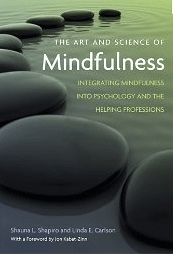The Art and Science of Mindfulness: Integrating Mindfulness Into Psychology and the Helping Professions

By Shauna L. Shapiro and Linda E. Carlson
American Psychological Association
Washington, D.C., 2009
Mindfulness explained in clear, rigorous work
Reviewed by Paul Efthim, Ph.D.
The term “mindfulness” probably evokes a mixed or even negative response for some psychologists. This is unfortunate because we in the helping professions have much to learn from Buddhist thought and meditative disciplines.
Why is the field of mindfulness not more fully embraced by psychologists? Possible explanations include a lack of accurate information about mindfulness, unfamiliar terminology, resistance to working with the body in a non-intellectual way and a general mistrust of spiritual and experiential perspectives.
However, research evidence supporting the effectiveness of mindfulness-based psychological interventions continues to grow. For readers who are interested in a clear, rigorous introduction to the subject, an excellent recent book by two leading research-practitioners fits the bill.
Perhaps the greatest strength of “The Art and Science of Mindfulness” is its accessibility. Authors Shapiro and Carlson lucidly explain the core principles of mindfulness, reassuring the reader that one does not need to become a Zen master in order to draw on mindfulness principles in working with patients and, indeed, ourselves.
Mindfulness, the authors explain, can be described as “the awareness that arises through intentionally attending in an open, caring and nonjudgmental way.” From this simple definition they go on to illustrate the process of cultivating this type of awareness through mindful practice, which consists of three elements: intention (being clear about why one is practicing), attention (observing one’s moment-to-moment internal and external experience) and attitude (infusing the act of paying attention with the qualities of curiosity, acceptance, openness and caring). Putting these three elements together is a complex task that requires patience and practice.
Most clinicians probably have sampled formal meditation practices but relatively few make it part of their lifestyle. The good news from this book is that there are plenty of ways in which one can practice mindfulness “informally.” The authors argue cogently that mindful awareness is at the center of good clinical work and that the practice of mindfulness can help therapists cultivate this awareness.
After defining mindfulness, the book devotes several chapters to different ways in which it can be incorporated into the therapeutic setting. Subsequent sections consider the research evidence, which is supportive but still in need of further clarification. Some research suggests a mechanism of action: mindfulness training facilitates a profound shift in perspective that leads to improved self-regulation, cognitive flexibility, exposure and clarification of unconscious values and assumptions.
The last section of the book covers self-care for clinicians and future directions for research and practice. Jon Kabat-Zinn, who has devoted his career to bringing mindfulness into the mainstream, writes in the foreword that teaching mindfulness is an art form that requires considerable skill and training. Thus, although we can certainly incorporate informal mindfulness practice into our own work – such as by noting our own breathing, attention and intention in session – we must guard against prematurely adopting a teaching role.
Two minor quibbles: there is only passing reference to patient selection and potential negative effects of meditation training; and the term “healing” is used liberally in reference to the psychologist’s role, a usage that can come across as off-putting and grandiose.
This volume is a terrific addition to the field and will be useful to practitioners in psychotherapy, medical and educational settings.
Paul Efthim, Ph.D. is a licensed psychologist in private practice in Brookline, Mass. and holds a faculty appointment at the Boston Institute for Psychotherapy.
Learn more about the book: The Art and Science of Mindfulness: Integrating Mindfulness Into Psychology and the Helping Professions
